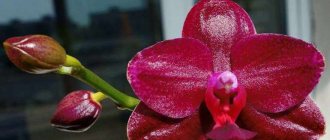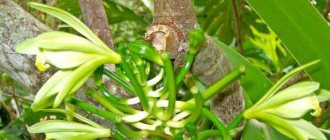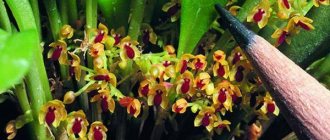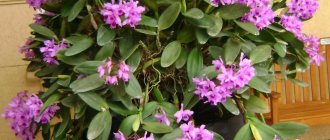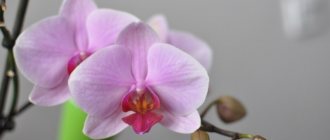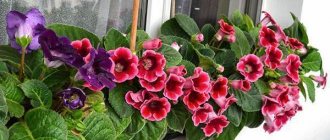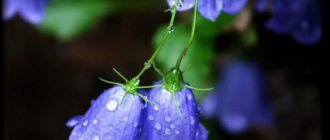Increasingly, exotic plants look at us through the glass windows of apartments and offices. Most of them delight the eye with long flowering, and the coloring of the flowers is usually very variegated.
Among the large number of overseas plants, a special place is given to orchids and, in particular, phalaenopsis. It is this type of epiphyte that is most often grown at home by both novice gardeners and specialists in this field.
Recently, it has become fashionable to present a bouquet of phalaenopsis in a pot instead of a bouquet for any occasion, and it is not necessary to choose among the flowering options. Plants with decorative leaves will surprise you no less than an orchid with the most colorful flowers.
Detailed description and photo
The Latin name for Sogo is Phalaenopsis Sogo. This type of orchid has very large flowers of different colors : from bright purple to white. Sogo's leaves are large, glossy emerald green, their length reaches 40 cm. The peduncles are unusually long and require special supports. This length ensures beautiful cascading flowering. Sogo orchid is not poisonous.
Phalaenopsis Sogo Cock:
Phalaenopsis Sogo Yukidian:
Phalaenopsis Sogo Gotris:
Phalaenopsis Sogo Pony:
Phalaenopsis Sogo Relex:
Temperature
Tropical species develop well at high daytime air temperatures of up to 30-32 degrees and night temperatures of at least 15 degrees. This applies to Phalaenopsis and Dendrobium orchids.
Natives of the subtropical forests of Odontoglossum and Miltonia prefer a more gentle daytime temperature of no higher than 25 degrees and a night temperature of 12-14 degrees.
But there are also fans of cool daytime temperatures of about 20 degrees, and night temperatures of about 12. These are Cymbidium orchids, Paphiopedilium and some other species.
Varieties
Sogo has several subspecies.
Vivien
The flowers of this species seem to be imbued with Asian motifs - they have crimson veins on pink petals. One petal is bright purple.
Yukidan
Incredible beauties in soft pink colors. On the peduncle, the buds stretch out one after another, falling down.
Lawrence
The petals of this subspecies of Sogo are red with yellow kayas . The lip is closer to red in color, sometimes with a white or purple tip.
Chabstic (Phalaenopsis Sogo Chabstic)
The Sogo orchid also has a miniature version - the subspecies Chabstic (Phalaenopsis Sogo Chabstic). The flowers are smaller in size, most often white with a purple lip.
Sogo orchid varieties, photo
Like every independent genus of the Orchid family, this one also produces “babies”. Groups of plants in this category have a lot of common features, but at the same time there are differences, which will be discussed below.
Relax
A variety that really surprises even experienced amateur plant growers. Flowers with “waxy” petals of a rich beet color have a scent similar to lilies, but not so strong. In the Russian Federation, this plant is supplied from Asia, but it is extremely difficult to find it on the open market. To acquire one, you will have to try and use the help of specialized groups or Internet sites that distribute phalaenopsis.
Sogo Relax is an unpretentious orchid and its care requirements are not much different from its counterparts grown in Holland. Any person who has positive experience in growing epiphytes will be able to cope without any problems.
This is interesting: this subspecies tends to grow arrows to extend the flowering period. Sometimes the process occurs for 7-8 months in a row.
Lawrence
It has red, non-fading dense petals with yellow edges. Sometimes the light tone is very narrow, and sometimes it takes up a significant part. The spots closer to the lip look more like stripes, and then disperse into dots. Some cultivators produce fragrant specimens, but this difference is not typical for all, as it strongly depends on the breeding conditions.
The arrow is branching, which causes a lush crown during flowering. The scarlet lip sometimes has a white or purple edge. The sepals are wide and the bud has a regular shape.
Sogo Lawrence is an orchid with blurry light spots on the leaf blades. This looks more than original and for the most part is characteristic only of this variety.
Yukidan
An elongated and slender plant with white or pink petals. The diameter of the open buds ranges from 12 to 14 cm. The lip is figured and resembles a brooch. The leaf blades are bright green, wide and dense, decorated with a longitudinal light vein in the middle.
The Sogo Yukidan orchid, as seen in the photo, looks like an elegant Asian figurine. The arrows are full of bright “moths” and bend to the ground under their weight. The petals are rounded and wide, shimmering in good light, like sugar.
This is interesting: the subvariety belongs to Doritenopsis - flowers obtained by crossing Orchids such as Doritis and Phalaenopsis.
Vivien
This plant has two features that significantly distinguish it from its other counterparts: the color of the leaves and petals. They are unique in their kind. Pink, lilac or purple flowers have veins that are a couple of shades darker and shimmer with iridescence. The dark green plates are bordered by wide, uneven light stripes. The sepals are full, and the petal is darker than the overall color.
Pony
Bright yellow flowers with large burgundy spots. The lip is crimson with a white border. The smell is pleasant and unobtrusive. Branched arrow. The green leaf blades sometimes have subtle light spots, like the Lawrence variety. As you can see in the photo, the rich open buds really look like exotic butterflies, standing out against the background of any plants.
Gotris
A dwarf beauty with an arrow no longer than 25 cm. The flowers are also not impressive in size, but they delight with bright colors and a delicate aroma. The yellow petals from the center of the bud have a red or pink tone that gradually dissipates.
Lip with a white tip and a small “nose”. The ovaries on the arrow are staggered, and it does not bend much under their weight after opening. In general, the plant resembles the Lawrence variety, but has significant differences in size and color type.
Rose
Phalaenopsis of this subvariety resembles Relax in appearance, only the tone of the petals is darker. “Waxy” buds are distinguished by long-term flowering, and against their background the lip practically does not stand out, only the edge is white. In some individuals, the sepals have a border and look as if the main light background, and the upper one consists of nearby large spots.
This is interesting: this plant belongs to the novelti variety - taking into account the conditions necessary for its healthy life, it blooms almost all the time.
Grape
The voluminous and slightly elongated petals of this variety are glossy and dense to the touch. The sepals are more shaped like the green plates of orchids than the usual buds. The lip stands out a little against the general deep lilac background with an orange color. Some subspecies come with a light thin border or a palette closer to cherry shades.
The younger the plant, the fewer ovaries there will be on the arrow. The leaf blades are wide and without “decorations”. In general, the variety is not large in size.
Bianca
A delicate creature of pale green or white color with pink and sometimes orange streaks. Lip with the same spot. The leaf blades have a shape characteristic of phalaenopsis and a healthy grassy color. The plant is dwarf and the arrow is short, without branches. Holds about 10 buds in a chaotic arrangement. Their disclosure is sequential.
Shito
Yellow background with white or pink spots closer to the center of the bud. The lip is the same color as the secondary tone. This variety has a pronounced smell, and the petals seem to be covered with wax. The height of the plant reaches a maximum of 40 cm. The arrow is short and replete with a small number of flowers.
Jessica
The embodiment of snow-white grace with a lilac core. The lip is large and more saturated in color than the sepals. The diameter of the buds and the size of the adult depends on age. Even when young, the epiphyte sometimes produces two arrows. Pleases with bright colors all year round.
This is interesting: the price depends on the type and prestige of the outlet, but ranges on average from 1 to 2.5 thousand rubles.
Landing
After purchasing seedlings, the plant must be immediately planted in a pot.
Choosing a pot
It is better to choose a new “home” for Sogo from transparent plastic materials . You will also have to make holes on the bottom and sides for air circulation. The root system is located freely, but the plant should not dangle in the pot.
What should the soil be like?
The easiest option is to buy a substrate suitable for orchids in a store. If you mix the soil yourself, it should contain:
- charcoal,
- sphagnum,
- pine bark in the form of medium-sized pieces.
How to plant?
Step-by-step instruction:
- Before planting the plant, examine the roots in detail. If there are dry, rotten shoots among them, you need to cut them off and treat the sections with a weak solution of potassium permanganate.
- First, we make drainage from expanded clay or polystyrene foam at the bottom.
- We lower the young plant into the pot and, without compacting it, cover it with soil prepared in advance.
- We check that there is enough space for the root system and that the orchid is securely fixed in the new place.
Hybrid characteristics
Before you go in search of a hybrid that has sunk into your soul, it is worth studying its indicators so as not to make a mistake when choosing a standard in a flower shop or greenhouse.
The Phalaenopsis Sogo orchid has the following external characteristics:
- In height the trunk can grow to medium size, together with the peduncle, this epiphyte develops up to 80 cm, but there are many dwarf and mini species of this plant;
Phalaenopsis Sogo are medium in size; the photo shows an adult specimen of Vivien. - An adult plant has 5-6 leaf blades , of medium size; mini-phalaenopsis have small leaves 8-10 cm long, and their width is no more than 5 cm;
- The arrow with buds develops depending on the variety , in ordinary ones it reaches 50 cm in length, mini-phalaenopsis have shorter peduncles;
- Sogo will also vary in the diameter of its flowers: most representatives of the variety have medium-sized flowers, reaching 6-8 cm in diameter, mini varieties are smaller - 4-5 cm in diameter.
Interesting! Phalaenopsis bloom in different colors, often one flower can combine several shades.
Caring for a plant at home
The Sogo orchid, like any other plant, requires regular care and attention.
- Temperature . The plant does not like cold. The lowest permissible temperature is 20 C° in any season. The upper temperature limit is 28 C°.
- Lighting . Sogo does not require any special solutions with light. You should not choose window sills that receive direct sunlight - this will help avoid burns. In hot weather, if there are no other windows in the apartment, it is necessary to shade them from the bright sun.
- Watering . A transparent pot allows you to determine the required frequency of watering based on the condition of the roots. If they look dry or brown, you can water them. Only the leaves are sprayed; water should not get on the flowers.
- Feeding . You can feed Sogo along with watering, observing the order. One time - just water at room temperature, the next - water with special fertilizers for orchids dissolved in it.
- Trimming . Pruning consists only of removing “used” flower stalks and dry leaves.
- Transplant . Sogo is replanted only when there is a need for it: the pot has become small or the soil is bad. It is better to choose the spring season for transplantation.
Care during the flowering period
Caring for a plant during flowering includes controlling temperature and lighting. In winter, most likely, you will have to illuminate the orchid with fluorescent lamps for several hours. After flowering, the ambient temperature can be reduced.
Moving Sogo to a cooler location will help the plant bloom again. Watering should be reduced.
What to do if the color doesn't pick up?
Most likely, the matter is due to improper watering or too frequent fertilization. A slight temperature difference will also help awaken the plant. In summer this can be done without difficulty, but in winter it is better to remove Sogo from the radiator at night, lowering the temperature by 5 C°.
Step-by-step care instructions
It is known that hybrid plants adapt more easily to indoor conditions, and Sogo is no exception. It’s just that her needs are a little different from most members of the family.
Important: all epiphytes of the genus cannot tolerate stuffiness. The room should be ventilated frequently, but without cold drafts.
Selecting a location
As mentioned earlier, orchids are afraid of open sun. Experienced collectors of these beautiful plants advise placing epiphytes on northern windowsills, but with additional lighting.
Preparing the soil and pot
When choosing a container, you should give preference to a transparent plastic product with large drainage holes. If there are none, but you like the pot, you can always make them yourself using a hot knife.
We recommend forming small holes in the side walls - excellent ventilation and simplifying the watering process by immersing the pot in water. The size is needed to be small, since growth goes upward, and not to the side, as in representatives with pseudobulbs from other genera.
The filler can be purchased at the store or mixed yourself.
Soil mixture:
- The drainage system is foam or expanded clay at the very bottom. Everything is disinfected.
- Charcoal - small pieces of leftover wood are placed between the roots. It is better to do this with your hands rather than in bulk.
- Moss - sphagnum retains moisture and even with irrigation type of irrigation distributes it everywhere. This material is part of the natural environment of epiphytes of the Orchid family.
- Pine bark - small elements (thoroughly washed and cleaned) are mixed with coal or placed on top, but loosely.
Temperature
Phalaenopsis are thermophilic, but do not tolerate heat well. During the day, the mercury column should not fall below +20 °C. Sudden jumps are also not welcome. This does not depend on the time of year, since Sogo does not need a rest period. Thus, it will bloom regularly and delight you with a healthy appearance.
Important: are you going to transport a plant, but it’s clearly colder outside than at home? A few days before this, you need to gradually change the location of the Sogo pot, placing it in an environment more similar to the street.
Humidity
A lot of liquid in the air is not required. It is enough to follow the usual regime, acceptable for humans - 50-60%. It is worth knowing that drying is more popular for orchids than flooding. If the summer turns out to be too hot, it is enough to spray the leaves once a day.
Lighting
In spring and summer, windows should be shaded. Of course, if they are from the south side. In winter, to extend the light period, it is recommended to use phytolamps, but for no more than two hours.
Watering
Compared to southern window sills, when located near northern windows, the moisture content of the soil mixture is rare. It is important to monitor the rhizome, because by its appearance it is easy to determine the condition of the orchid. If a gray-brown color appears, it means it needs water.
The buds should not be irrigated, otherwise unsightly spots will form. The leaves are sprayed, but it is worth considering that the roots also receive moisture. In the autumn-winter period, 1-2 times a week is enough, and in the heat - once. All these manipulations should be performed in the first half of the day, so that during the rest of the day the epiphyte absorbs the maximum and the excess evaporates.
Important: if overwatered, the plant may rot and begin to hurt. In most cases, the matter ends in death.
Top dressing
Performed simultaneously with watering. We recommend adding any rooting agent for better development of the rhizome. Apply special mixtures no more than once a month. They are not very necessary, but they will not harm the young animals. In any case, you should alternate between clean water and water mixed with fertilizers. After the buds appear, fertilizing is not advisable.
Transfer
After purchasing a young orchid, place the pot in quarantine for 2 weeks. During this time she will have time to adapt. Then it can be transplanted.
Subsequence:
- We use the transshipment method without destroying the old earthen ball. The substrate must be dry. Squeeze the pot on both sides. Carefully remove the plant with all its contents.
- If there was drainage in the old container, it is better to leave it there and put a fresh one in the new place. The embankment should occupy no more than 1/4 of the total space.
- Place the earthen ball in a new container that is larger than the previous one.
- Cover with suitable substrate. Do not tamp or push the flower! If part of it remains uncovered, it's okay. This is an epiphyte.
- Place the pot in a bowl of settled water at room temperature. Let stand for 15 minutes and remove. All excess should drain off.
Important: the leaf axils should not be wetted.
This method is only relevant for healthy individuals. Sometimes “moving” becomes forced due to illness, and the rhizome should be cleared of the soil mixture and further treated with a special preparation. Cleaning with a sterile instrument is also required in the presence of rotten (flaccid) roots.
How does it reproduce?
You can propagate this type of orchid with the help of children.:
- At the beginning of spring, when the plant has faded, but the peduncle is not yet dry, use a sharp sterile knife to cut off the shoot with the bud.
- The cut areas can be treated with charcoal.
- The shoot is immediately placed in a small pot of soil.
It is better not to water an adult plant for several days after this.
How to propagate?
In greenhouses this is done with the help of seeds and “babies”. The last method is the only one possible for increasing the number of epiphytes at home.
Step-by-step description of the procedure:
- Choose an adult with a healthy rhizome as the mother. The peduncle should still be fresh, but without buds.
- Using a sterile instrument, cut the “dormant” bud. If there are any on the stem, you can use them too.
- Sprinkle the wound with crushed coal or cinnamon. Otherwise it may rot.
- The baby will develop on the maternal trunk for another 1-2 months. He needs to grow 2-3 leaves and the same number of roots.
- Only after this can they be finally separated and placed for cultivation.
Diseases and pests. Treatment/control methods
Pests and diseases that can affect Sogo:
- Rotten . They can appear on almost any part of the plant if the orchid is “flooded” or the room where it stands is not ventilated. Replanting, cleaning the roots, and temporarily stopping watering will help.
- Mealybugs . As soon as the pest is detected, it must be immediately removed from the plant. The leaves are treated with confidor, after spraying the sinuses need to be wiped of excess water. The plant is allowed to dry in a warm room and the procedure is repeated after a week.
- Spider mite . It multiplies, entwining the entire Sogo with a web. Spraying with phytoverm and repeating the procedure after a week will help against this ailment.
To avoid a new infection, it is better to treat the window sill, pot and all tools used with copper sulfate. Rinse all supports well and wash the curtains.
What is the difference from other types?
- The peduncle is long, so the plant needs support.
- The leaves can be not only green, but also have multi-colored stripes. They can be very diverse: thin, bright, wide, blurry or in the form of a border.
- Bright flowers are arranged in a cascade on the peduncle.
- It is unpretentious, easy to care for, observing temperature conditions, lighting, watering and feeding correctly.
- It does not tolerate dampness and stuffiness, so it is necessary to ventilate the room even in winter, but you need to beware of drafts.
Prevention of various problems
The best prevention is proper care and maintenance of the indoor microclimate necessary for Sogo. Treat the plant immediately when diseases appear and adjust the frequency of watering. Before transplanting and propagating the orchid, be sure to treat the tools and the new pot. When ventilating, do not leave the plant in a draft to avoid freezing.
The Sogo orchid is just one of the representatives of these beautiful flowers. Perhaps, once you start with it, it will not be easy to stop and the beauty of orchids will captivate you forever. And caring for the Sogo species will be a great start, which will help you gain the necessary experience.
Description
One of the types of phalaenopsis Sogo is Gotris.
Most Phalaenopsis Sogo There are also varieties with plain leaf blades.
A special feature of the Sogo variety is that it belongs to variegated plant varieties. What is it?
The term variegated refers to plants that have uneven foliage color .
A wide variety of tones and shades can be present on the leaf plates of the trunk; the most common leaves are:
- Green-white;
- Red-green;
- Green-violet.
It is the colored leaf plates that attract the attention of a plant of this type.
The colors on the leaves can be very diverse; nature decorated them at its discretion.
There are only thin stripes of unusual shades , and sometimes it is the greenery that appears as the edging.
The colored stripe can run strictly in the middle, or it can frame one edge of the sheet with a thin line.
Orchids in combination with colorful and fragrant flowers will be an excellent holiday gift or just for a good mood.
The Sogo standard has species with white-green leaves , but there are other differences.
Varieties of mini orchids
It would be strange if the largest number of miniature orchids were not bred on the basis of the most popular variety of this flower. Unpretentious phalaenopsis have gained immense popularity among gardeners all over the world, and it is representatives of this genus of orchids that can be found on sale most often.
However, in reality, miniature hybrids can be found in the “lines” of many other orchid genera. In addition to phalaenopsis, the following are also grown at home:
- mini dendrobiums;
- mini cattleyas;
- mini-oncidiums;
- mini-paphiopedilums (lady's slipper);
- mini cymbidiums.
The main thing you need to pay attention to when choosing hybrids for growing in an apartment is not the size, but the genus. You will have to tinker with a miniature cymbidium no less than with a “full-scale” flower. In this case, a mini-phalaenopsis will not take much more time than a regular one.
The good news is that if you have mastered the basic techniques for growing specific varieties of orchids, then adapting to caring for their miniature copies will not be too difficult for you.
Popular mini-phalaenopsis: Sogo Vivien, Mini dog, Mini Mark.
- Which orchid to choose for a beginner - advantages and disadvantages of popular types
Plunge into the luxurious world of orchids and choose a new tenant for your home or winter garden!
Transfer
Orchids are highly undesirable unless necessary. The roots are very fragile, and this creates certain difficulties during transplantation. But if you decide to replant the plant, carefully examine the roots and remove rotten or dry and damaged areas.
The substrate in the pot is changed completely. The pot should not be much larger than its predecessor, otherwise the orchid will begin to actively grow leaves instead of flowering. After transplantation, the plant is not watered for 3 days and not fed for a month. On average, a transplant has to be done once every two years.
Phalaenopsis sogo relax
| Sogo Cherry | Sogo Shito 'Montclair Gold Rush' |
| Sogo Rose 'Lee' | Sogo Mandolin |
| Sogo Lisa | Sogo Black |
| Sogo Lawrence | Sogo Lawrence #2 |
| Sogo Festival | Sogo Yenlin |
| Sogo Gotris | Sogo Popcorn |
| Sogo Tris | Sogo Vision |
| Sogo Allen | Sogo Bianca |
| Sogo Dunia | Sogo Pearl |
| Sunrise Katherine | Sunrise Delight 'Orange Beauty' |
| Siera Gold | Sogo Vivien |
| Sunny | So Pearly, Rainbow City |
| Shiuhdong Sweetheart 'Jumbo Ruby' | Surf Song flower 8 cm |
| Starfish | Starfish #1 |
| Sun Passat |
"A" "B" "C" "D" "E" "F" "G" "H" "I" "J" "K" "L" "M" "N" "O" "P" "Q » “R” “S” “T” “U” “V” “W” “X” “Y” “Z”
Top 10 beautiful fragrant orchids – Indoor flowers
Imperceptibly, step by step, beautiful orchids entered our lives and no longer seem like some kind of unusual flower. With a little practice, you can become the owner of a chic collection of these amazing flowers. Personally, what attracts me to them is the long flowering period. Some representatives of these beautiful flowers lose their pleasant scent.
I bring to your attention the top 10 beautiful fragrant orchids. compiled solely from my personal preferences. So, a hit parade of exotic beauties.
Phalaenopsis Malibu Imp
10) Phalaenopsis Malibu Imp. Its aroma is very strong, pleasant oriental-spicy
Phalaenopsis stuartiana
9) Phalaenopsis stuartiana. During the day, this beauty exhales a faint smell of coffee
Phalaenopsis Orchid World
Phalaenopsis Orchid World. Won love with a strong scent of citrus and rose
Phalaenopsis Sogo David
7) Phalaenopsis Sogo David will fill the room with the scent of narcissus
Phalaenopsis Ho's Black Cherub 'ORCHIS'
6) Phalaenopsis Ho's Black Cherub 'ORCHIS' - caramel aroma with a bitter note
Phalaenopsis modesta
5) Phalaenopsis modesta weakens the strong lily scent during the day
Phalaenopsis hieroglyphica
4) Phalaenopsis hieroglyphica smells like roses
Phalaenopsis mannii
3) Phalaenopsis mannii. This phalaenopsis, discovered in 1868, is known for its faint jasmine scent. This orchid was first discovered in India by Gustav Mann. The plant is only 5 cm high. But about 70 flowers can develop on a peduncle.
Phalaenopsis violacea
2) Phalaenopsis violacea with a strong pleasant floral aroma. In nature, this orchid can be found in Malaysia. On the arched peduncles of phalaenopsis, flowers open in a “queue” - 1-2 buds at a time.
Phalaenopsis javanica
1) Phalaenopsis javanica will delight fans of the aroma of violets. This species is almost on the verge of extinction: today there are only one dozen natural Phalaenopsis javanica in the Bogor Botanical Garden.
As a result of the destruction of forests for industrial purposes, the plant has practically disappeared in nature and still remains rare in cultivation.
Do not cut off the old peduncle - the plant can bloom on it for several years in a row, throwing out new peduncles each flowering.
The above top 10 beautiful fragrant orchids are participating in a competition held on the blog //andreyspektor.com/. The competition lasts until February 9. So you can hurry up and take part in it!!
That's all for today! Share the information with your friends! They will be interested to learn about fragrant, beautiful orchids!
komnatnye-tsvety.ru
Phalaenopsis Sogo Relex F-1661
Phalaenopsis is native to the dense tropical forests of southern Asia (southern India, Taiwan and the Philippines), New Guinea and Australia. This biological species has up to seventy varieties, in addition, there are thousands more different hybrids and varieties. These are plants with greatly shortened stems.
The leaves are evergreen, 10-30 cm long, collected in a rosette from which flower stalks and aerial roots grow. For its color and shape of the petals, similar to the fluttering wings of a butterfly, this flower was called “orchid-moth” or “orchid-butterfly”.
You can find phalaenopsis with a single flower, as well as with many inflorescences that fit on one stem. The stem can reach a length of sixty centimeters and bear up to twenty inflorescences.
Phalaenopsis is the most unpretentious plant of the orchid family, and for beginners it is recommended to breed orchids from it.
Thanks to its lush and frequent flowering and excellent adaptation to indoor conditions, this plant has become the most popular of the genus of orchids grown indoors. Before purchasing, carefully inspect the plant: the roots should be green and silver.
Characteristics
Flower color purple Flowering period every six months Flowering duration 8 weeks Maximum height 30 cm.
Premises requirements
Lighting is bright, humidity is average, temperature in summer is +25+30C, in winter +18+25C.
Phalaenopsis needs an influx of fresh air, but it is important that there is no draft. Almost all species feel comfortable during the day from +22 to +30C, at night not lower than +16. Drafts and excessive heat are dangerous for the plant.
Cooler temperatures promote flowering, hotter temperatures promote the appearance of flowers on the peduncle. Phalaenopsis love bright light, and if there is no sun, you can use artificial light (fluorescent lamps).
Do not place the orchid in direct sunlight (burns are possible). At temperatures above +35° C, the orchid must be placed in a cooler place, and the roots and foliage should be sprayed with warm water.
Phalaenopsis requires bright light for at least 12 hours in winter. With insufficient lighting, flower growth slows down, and in winter the orchid may go into a dormant state.
For additional illumination, fluorescent lamps emitting a white glow are used. However, if you do not have the opportunity to additionally highlight the flower, nothing bad will happen.
Your orchid will actively develop in the spring-summer period and rest with the onset of winter.
In order for your orchid to bloom, a number of conditions must be met:
- move the flower pot as little as possible;
- do not allow sudden changes in temperature;
- provide the plant with sufficient light;
- Monitor the air humidity in the room.
You need to water with filtered, boiled or settled water, abundantly (by immersion), but rarely (in the summer once every 4 days, in the winter once every 7). Wait for the water to drain, remember that overfilling is much worse than underfilling. Irrigation water should not get into the growing point (the center of leaf growth) to avoid rotting.
Mostly mineral fertilizers with a certain level of acidity are suitable for phalaenopsis. Typically, fertilizers for orchids contain much less microelements than for ordinary indoor plants.
When choosing fertilizer, preference is given to liquid forms, as it will save you from the need to weigh and measure proportions.
In addition, pay attention to the presence of special ingredients that prevent the accumulation of excess salts.
Remember that for a healthy plant, the root type of feeding is preferable. For a plant with a damaged or practically absent root system, spraying can be carried out.
Transplantation is carried out mainly in the spring. In addition, the plant may need a new home immediately after purchase. For transplantation, you can buy a ready-made substrate. The orchid must be removed from the pot and the root system must be cleaned of the substrate.
Then you need to inspect the flower, remove yellowed leaves and rotten roots, treat the cuts with an antiseptic and dry the flower. It's best to let it sit overnight. The next day you can start transplanting.
To do this, take a new pot, place drainage in the form of expanded clay at the bottom, place the orchid in the center of the container and cover it with prepared bark. There is no need to fall asleep too much, remember that the roots need access to oxygen.
Reproduction of phalaenopsis at home is quite problematic. Often the formation of children on the mother's peduncle, which are then transplanted into the prepared substrate.
Among orchids, the most common diseases are those caused by improper care. In addition, phalaenopsis is very susceptible to rot, powdery mildew and fungi. The most commonly observed pests are mealybugs and citrus bugs.
orchidea-shop.ru
Source: //ae-flowers.ru/falenopsis/falenopsis-sogo-relaks.html
How to grow at home?
The home bloom of the orchid is quite long, the flowers cascade spectacularly down the arrow. In order to admire this beauty for as long as possible, you need to create the necessary favorable conditions:
- to stimulate flowering, you can slightly reduce the room temperature and also reduce the amount of humidification in winter;
- with the beginning of spring, the ground is watered more often, the plant is sprayed;
- Immediately after flowering ends, the flower stalks should not be cut off, since after a while the buds will appear again.
